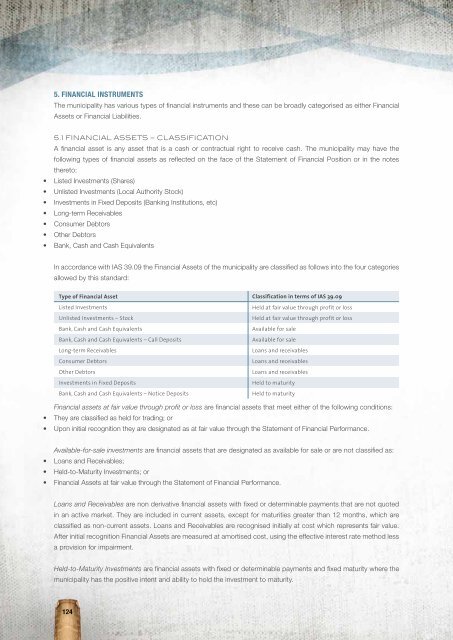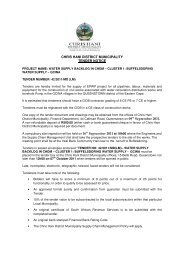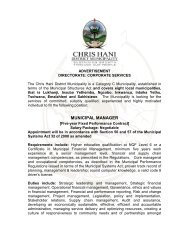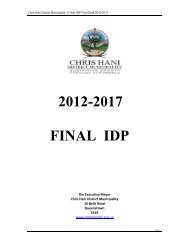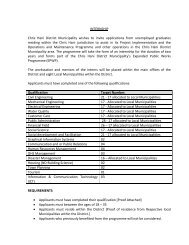Entire Document - Chris Hani District Municipality
Entire Document - Chris Hani District Municipality
Entire Document - Chris Hani District Municipality
You also want an ePaper? Increase the reach of your titles
YUMPU automatically turns print PDFs into web optimized ePapers that Google loves.
5. FINANCIAL INSTRUMENTS<br />
The municipality has various types of financial instruments and these can be broadly categorised as either Financial<br />
Assets or Financial Liabilities.<br />
5.1 Financial Assets – Classification<br />
A financial asset is any asset that is a cash or contractual right to receive cash. The municipality may have the<br />
following types of financial assets as reflected on the face of the Statement of Financial Position or in the notes<br />
thereto:<br />
• Listed Investments (Shares)<br />
• Unlisted Investments (Local Authority Stock)<br />
• Investments in Fixed Deposits (Banking Institutions, etc)<br />
• Long-term Receivables<br />
• Consumer Debtors<br />
• Other Debtors<br />
• Bank, Cash and Cash Equivalents<br />
In accordance with IAS 39.09 the Financial Assets of the municipality are classified as follows into the four categories<br />
allowed by this standard:<br />
Type of Financial Asset Classification in terms of IAS 39.09<br />
Listed Investments<br />
Unlisted Investments – Stock<br />
Bank, Cash and Cash Equivalents<br />
Bank, Cash and Cash Equivalents – Call Deposits<br />
Long-term Receivables<br />
Consumer Debtors<br />
Other Debtors<br />
Investments in Fixed Deposits<br />
Bank, Cash and Cash Equivalents – Notice Deposits<br />
Held at fair value through profit or loss<br />
Held at fair value through profit or loss<br />
Available for sale<br />
Available for sale<br />
Loans and receivables<br />
Loans and receivables<br />
Loans and receivables<br />
Held to maturity<br />
Held to maturity<br />
Financial assets at fair value through profit or loss are financial assets that meet either of the following conditions:<br />
• They are classified as held for trading; or<br />
• Upon initial recognition they are designated as at fair value through the Statement of Financial Performance.<br />
Available-for-sale investments are financial assets that are designated as available for sale or are not classified as:<br />
• Loans and Receivables;<br />
• Held-to-Maturity Investments; or<br />
• Financial Assets at fair value through the Statement of Financial Performance.<br />
Loans and Receivables are non derivative financial assets with fixed or determinable payments that are not quoted<br />
in an active market. They are included in current assets, except for maturities greater than 12 months, which are<br />
classified as non-current assets. Loans and Receivables are recognised initially at cost which represents fair value.<br />
After initial recognition Financial Assets are measured at amortised cost, using the effective interest rate method less<br />
a provision for impairment.<br />
Held-to-Maturity Investments are financial assets with fixed or determinable payments and fixed maturity where the<br />
municipality has the positive intent and ability to hold the investment to maturity.<br />
124


